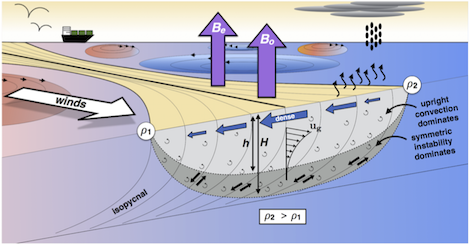Submesoscale processes

Submesoscale processes occurring within the upper ocean have attracted considerable attention within the past 15-20 years. This has likely been prompted by an increase in spatial and temporal resolution within (a) numerical simulations of the ocean and (b) ocean observations. The former can be attributed to increased computational capability, while the latter has almost certainly resulted from autonomous technological developments (e.g., ocean gliders, SailDrone, float technology). Dynamically, these small-scale processes are expected to have implications for biogeochemistry (e.g. carbon exchange) and ocean circulation. Submesoscale processes in the ocean include but are not limited to the following: (1) baroclinic instability and (2) symmetric instability. My coauthors and I have examined both processes. However, for brevity, the second of these instabilities is detailed below.
Symmetric instability
In a collaborative effort involving numerous institutions (UKMetOffice, University of Reading, Bangor University, University of Southampton, and University of Grenoble), my colleagues and I aimed to understand the contributions of surface and submesoscale processes to turbulence in the ocean surface boundary layer. We employed a new parameterization of Langmuir turbulence, an existing parameterization of submesoscale-generated turbulence, and a five-month set of moored observations to conduct this study. Langmuir turbulence was parameterized using large eddy simulations (LES), while the submesoscale turbulence parameterization relied upon existing work pertaining to wind- and buoyancy-forced symmetric instability (Thomas and Taylor, 2010). Using observations, we showed that dissipation of turbulent kinetic energy (i.e. energy loss) due to submesoscale processes were one to two orders of magnitude smaller than those due to surface processes. We obtained similar results when we applied the same framework to a front-resolving (dx = 1 km) ocean model. In summary, we suggest that upper ocean turbulence due to submesoscale processes is a magnitude or more smaller than turbulence generated by surface processes (i.e. winds, waves, & surface heat loss). We remark, however, that the net effect of symmetric instability might be appreciable, as it removes considerable energy from the large-scale ocean circulation (Buckingham et al. 2019; Dong et al. 2021).
